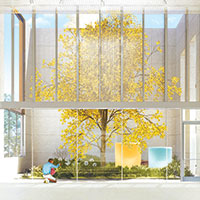 Garden-centric museum will be a spectacle inside and out
Garden-centric museum will be a spectacle inside and out
STORY BY JON PINE (Week of November 13, 2025)
The $126 million transformation of the Vero Beach Museum of Art is now officially underway.
More than 200 dignitaries and donors joined the staff and leadership of the Vero Beach Museum of Art last Friday to break ground for the two-year project.
When it is completed, the museum – already one of the nation’s best attended small museums – will offer visitors more than 100,000 square feet of new public space joined by expansive terraced gardens.
“I think this project could only happen in Vero Beach – a place that has developed a well-deserved reputation for its generosity and support for cultural organizations,” Brady Roberts, the museum’s executive director, told those at the groundbreaking.
More than $100 million of the “Museum in the Garden” capital campaign has been raised already, with over half of that coming from members of the museum’s board of directors, Roberts added.
Vero Beach Mayor John Cotugno called the museum “a true civic anchor where children discover creativity, families explore together, and adults of all ages find inspiration.”
More than 14,000 square feet of terraces and courtyards are designed to lead visitors to three entrances into the new, two-story museum and education building, with the main entrance facing the ‘Under the Oaks’ section of Riverside Park and opening into a gallery of contemporary art.
The layout “creates multiple invitations to come into the museum,” Roberts said. “Now the museum becomes the natural thoroughfare in the park. We’re creating an acre and a half of green space in this project. It’s a design that’s made for the environment; it respects the environment and is part of it.”
“The conception of the building from the very start began with an idea about gardens and terraces,” said Brad Cloepfil, founder of the project’s architecture and design firm, Allied Works. “Before I even had an idea about the building form itself, I saw the spirit of the place as a series of gardens for art.
“This museum is like no other place I’ve ever visited or seen. It’s so bound to the landscape and the climate and context that it is extraordinarily specific to Vero Beach. I wanted it to be a garden first, which the museum kind of grows out of.”
The gardener will be landscape architect Claire Agre of Unknown Studio. “I know Claire,” Cloepfil said. “I know her work. I know her mind. The reason we wanted to work with Claire and Unknown was because of their understanding of gardens.”
The studios work well together because both are open to exploring a range of possibilities and circling back to modify the design when necessary, Agre said. “I felt we were very simpatico in that and we really embraced the creative process. Then there are these ‘eureka’ moments and you come back together and modify. Both teams are on the same page that way.”
The site of the new museum building – situated west and north of the existing museum – will be elevated 9 feet to lift the structure out of the flood plain, while also affording enhanced views of the lagoon and park through banks of windows. The building will be connected to the two-story hurricane-resistant bunker built in 2012 that is dedicated to art storage.
When the new building is completed, the original 40-year-old museum, which was built piecemeal, will be demolished, creating space for the expansive gardens and terraces.
“The terraces step up from a few feet above sea level to the elevated first floor,” Agre said. “So, as you’re moving through the space, they transform as you go up these slopes and through the terraces from something naturalistic to something awe-inspiring, awakening and super designed.”
“People connect to gardens in a very visceral way,” Agre said. “We think they’re really important because they connect people to nature. Today, we are in crisis ... losing our kinship and connection to the natural world.”
Cloepfil and Allied Works have been designing museums for the past 20 years. The ongoing conversation in the office is about how to engage communities, grow collections and redefine what museums mean in today’s culture.
“This project was conceived as a place of refuge,” Cloepfil said. “That was the first idea for the museum.”
About 30 live oak trees will be relocated onto the terraces, according to Agre. It’s an expensive process, but well worth it, she said. “It’s a good conservation move, but it’s also an experiential benefit for this project. Oaks have more biodiversity than any other species of tree.”
The project also includes other shade trees, Agre said, including “the most beautiful tabebuia tree known to creation,” which will be clearly seen through a glass wall in the Modern Contemporary art gallery opposite the main entrance.
The tabebuia tree is native to Brazil. While lower levels feature mostly native plants, the trees and plantings get more cultivated the higher the terraces climb, according to Agre, who notes there will be a rooftop garden as well.
Having a mix of native and non-native plants means extra maintenance will be necessary, but the museum and the designers are willing to take on those tasks for the sake of a living design.
“We need to make sure the things we’ve intended to grow are maturing and not getting invaded by other species,” Agre said. “It’s not a ‘mow and blow’ landscape. We could have just done a turf mound with a monument on top, but that’s not interesting.”
Over time, it will become clear which plants thrive and which ones might need to be replaced, she said. “Landscape architecture is always a very open-ended experiment. It will be beautiful, whichever way it evolves.”
The same is true of the indoor spaces and galleries, Cloepfil added. “We’ll see how they evolve and how the community embraces them. One of the interesting things about this project is that this is an absolutely unique institution.
“You’ve got the school, the humanities program, the collections and the park. The terraces are designed with an eye toward having outdoor events. But we also want people to just drop by during the day to hang out.
“Even if they don’t go in, we wanted them to feel invited and welcome. Eventually, their curiosity will be piqued and they’ll wander inside,” he said.



